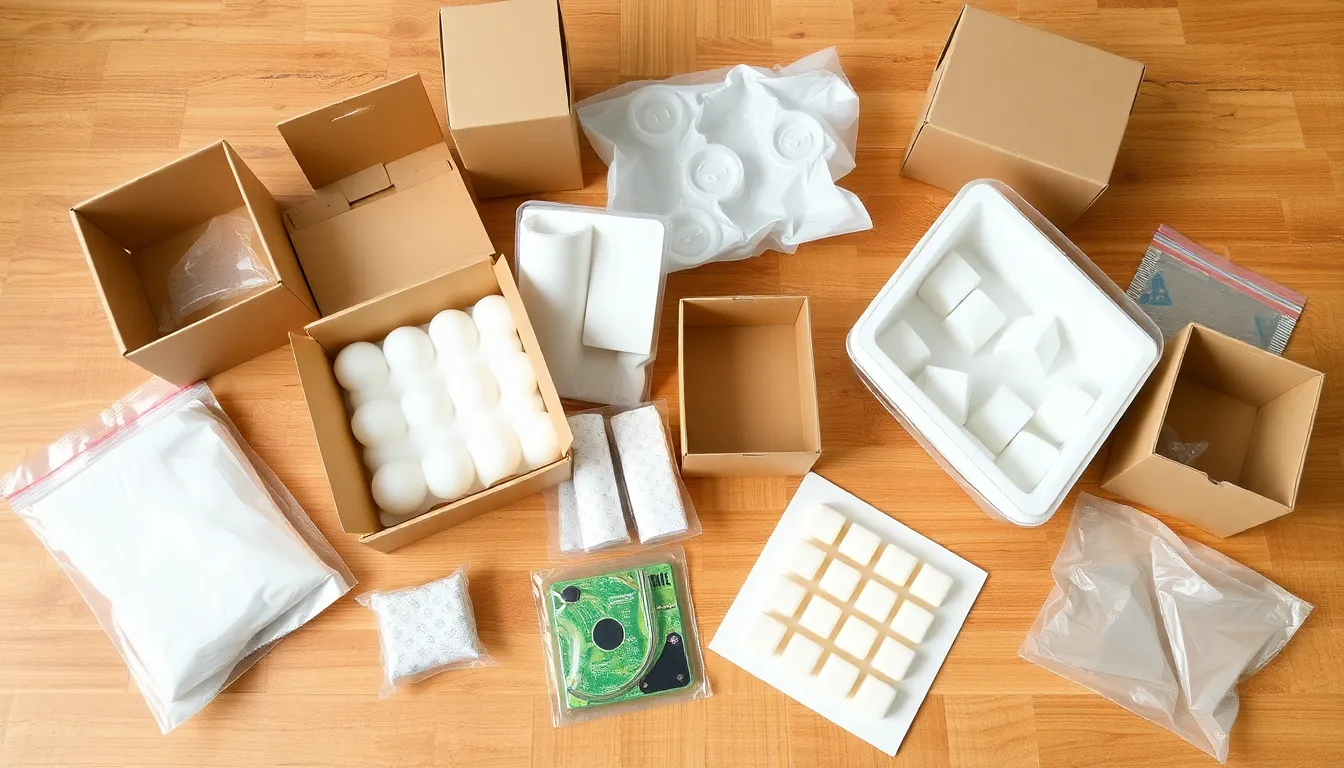In a world where gadgets reign supreme, the packaging often plays second fiddle, but it shouldn’t. Picture this: you just snagged the latest smartphone, and it arrives in a box that looks like it’s been through a wrestling match. Not exactly the grand unboxing experience you dreamed of, right? Consumer electronics packaging isn’t just about protecting devices; it’s about creating an unforgettable first impression that screams, “I’m worth your time!”
From eco-friendly materials to sleek designs, packaging can make or break a product’s appeal. It’s not just a pretty face; it’s a vital part of the customer journey that can boost brand loyalty and sales. So, let’s dive into the fascinating world of consumer electronics packaging and discover how it’s evolving to meet the needs of both consumers and the planet. Who knew cardboard could be so exciting?
Consumer Electronics Packaging
Consumer electronics packaging plays a vital role in product presentation and user experience. Effective packaging captures attention while ensuring protection for electronic devices.
Importance of Packaging in Consumer Electronics
Packaging significantly influences consumer perceptions, balancing aesthetics with functionality. Compelling designs enhance the unboxing experience, bolstering brand loyalty. Brands recognize that effective packaging can drive sales by communicating product features clearly. Safety remains paramount; protective materials safeguard devices against impacts and potential damage during transport. Additionally, consumers increasingly prefer sustainable packaging solutions, prompting brands to adopt eco-friendly materials that align with their values.
Key Trends in Packaging Design
Innovative designs reflect evolving market demands and consumer preferences. Minimalist packaging continues to gain traction, emphasizing simplicity while maintaining product visibility. Smart packaging, integrating technology like QR codes and NFC, encourages interactive customer engagement. Customizable options allow brands to offer personalized experiences, appealing to individual preferences. Eco-conscious approaches, utilizing biodegradable materials, highlight sustainability, appealing to an environmentally aware consumer base. As competition increases, unique packaging solutions become critical for differentiation in the marketplace.
Materials Used in Consumer Electronics Packaging

Consumer electronics packaging relies on various materials to meet different product and consumer needs. Selecting the right materials ensures effective protection and enhances user experience.
Types of Packaging Materials
Cardboard, plastic, and foam represent common types of packaging materials. Cardboard offers sturdiness and flexibility for boxes that accommodate multiple product sizes. Plastic provides moisture resistance, making it suitable for outer packaging like blister packs. Additionally, foam acts as a cushioning agent, safeguarding fragile electronics during transport. Some brands utilize biodegradable and recyclable materials, promoting eco-friendliness while maintaining durability. Innovative materials also emerge, such as molded pulp and bioplastics, combining functionality with sustainability.
Environmental Considerations
Eco-friendly practices gain importance in consumer electronics packaging. Many companies adopt recyclable materials to minimize environmental impacts. Selecting sustainable options helps reduce waste and resonates with environmentally conscious consumers. Biodegradable packaging options also emerge as alternatives to traditional materials, promoting responsible disposal. Using minimal packaging design increases efficiency and decreases resource consumption. Regulatory pressures also spur this shift, encouraging brands to prioritize environmental goals.
Packaging Innovations in Consumer Electronics
Innovative trends in packaging are shaping the consumer electronics landscape. These advancements enhance user experiences while addressing environmental concerns.
Smart Packaging Technologies
Smart packaging integrates digital features into product design. This technology enables consumers to engage with products through interactive elements. Examples include QR codes that provide additional product information or NFC tags that enable connectivity with smartphones. Such features enhance customer interaction and provide real-time updates on product usage. Enhanced tracking capabilities also help monitor shipment conditions, ensuring devices arrive in optimal condition. These technologies not only improve customer satisfaction but also strengthen brand loyalty.
Sustainable Packaging Solutions
Sustainable packaging solutions increasingly dominate the consumer electronics sector. Brands prioritize eco-friendly materials, aiming to reduce environmental footprints. Recyclable plastics and biodegradable materials offer practical options for creating responsible packaging. For instance, companies are utilizing cornstarch-based products instead of traditional plastics. This transition responds to consumer demands for sustainability while meeting regulatory standards. Brands adopting these practices show a commitment to environmental responsibility, which resonates with environmentally conscious consumers. Thus, sustainable packaging not only protects products but also promotes brand values aligned with consumer expectations.
Challenges in Consumer Electronics Packaging
Packaging in the consumer electronics sector faces various challenges that require strategic solutions. Key factors like supply chain issues and evolving consumer expectations play a significant role in shaping packaging strategies.
Supply Chain Issues
Supply chain disruptions frequently impact the availability of packaging materials. Manufacturers encounter delays in receiving essential components, which complicates production timelines. Limited access to eco-friendly materials can hinder sustainability initiatives. Increasing transportation costs also affect overall packaging expenses. Adapting to fluctuating market demands requires agility in sourcing materials. Companies must establish reliable supplier relationships to mitigate risks. Prioritizing local suppliers may enhance resilience against global supply chain challenges.
Consumer Expectations
Consumer expectations significantly influence packaging choices and designs. Today’s customers prefer packaging that enhances the unboxing experience and communicates quality. Increasingly, buyers seek sustainable options, emphasizing recyclable and biodegradable materials. Clarity in product information also matters; consumers appreciate transparent labeling of features and benefits. Minimalist designs often attract attention and convey modernity. Products delivered in eco-friendly packaging strengthen brand loyalty by aligning with environmentally conscious values. Brands must continually adapt to these changing preferences to stay competitive in the dynamic consumer electronics market.
Future of Consumer Electronics Packaging
Consumer electronics packaging continues to evolve, driven by emerging technologies and changing industry trends. Significant advancements shape how products are presented, protected, and enjoyed by consumers.
Emerging Technologies
Interactive packaging incorporates technologies like QR codes and embedded NFC chips. These features create a dynamic unboxing experience, allowing users to access product information and engage with brands instantly. Augmented reality applications transform static packaging into immersive experiences, enhancing consumer interaction. Smart sensors also track shipment conditions, ensuring devices arrive undamaged. These innovations support the alignment of consumer expectations with modern functionalities, reinforcing the importance of engaging packaging in the electronics sector.
Predictions for Industry Trends
Sustainability will remain a top priority as consumer demand intensifies for eco-friendly packaging solutions. Brands are expected to invest in recyclable materials, advancing biodegradable options to meet regulatory requirements. Transparent labeling practices will gain traction, offering consumers clear information on environmental impacts. Minimalism in design will persist, providing a clean aesthetic that consumers appreciate. Enhanced customization options will also emerge, catering to personal preferences and reinforcing brand loyalty. Companies adapting to these trends will likely outperform competitors, maintaining relevance in a rapidly changing market.
Conclusion
The landscape of consumer electronics packaging is evolving rapidly. As brands strive to differentiate themselves in a competitive market, effective packaging emerges as a vital tool for enhancing user experience and fostering brand loyalty. Embracing innovative designs and sustainable materials not only addresses consumer demands but also aligns with environmental responsibilities.
By prioritizing packaging that balances aesthetics and functionality, companies can create memorable unboxing experiences. The integration of smart technologies and eco-friendly practices will likely play a significant role in shaping future packaging strategies. Brands that adapt to these trends will not only meet consumer expectations but also secure their position in the ever-changing marketplace.


